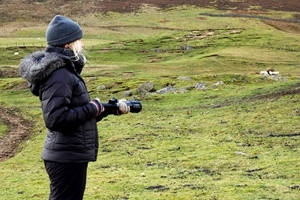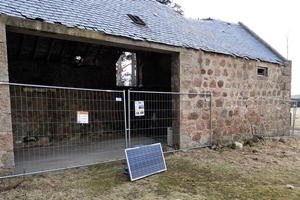 The LIFE-funded LaserFence project, led by Liverpool John Moores University, started in September 2016 with the aim of testing a modified bird-scaring laser device on mammalian pests. The original device, developed by Bird Control Group in the Netherlands, works simply by projecting a small green disc onto the ground close to the target birds; the movement of this disc is sufficient to scare the birds away. If the new Laser Fence system can be adapted to have a similar effect on certain mammals, it might provide a simple alternative to less desirable or more expensive options, such as poison baits and permanent fencing.
The LIFE-funded LaserFence project, led by Liverpool John Moores University, started in September 2016 with the aim of testing a modified bird-scaring laser device on mammalian pests. The original device, developed by Bird Control Group in the Netherlands, works simply by projecting a small green disc onto the ground close to the target birds; the movement of this disc is sufficient to scare the birds away. If the new Laser Fence system can be adapted to have a similar effect on certain mammals, it might provide a simple alternative to less desirable or more expensive options, such as poison baits and permanent fencing.
Trials were planned at sites in England, Spain, the Netherlands and at our Game & Wildlife Scottish Demonstration Farm, Auchnerran. We have two types of device at our disposal: a handheld laser and a programmable, automated version. The handheld device is very easy to use and offers the opportunity to collect lots of data on how individual animals respond when the green laser is projected close to them. The autonomic device allows us to set up the machine in a defined area so we can investigate whether it can keep animals away over relatively long periods of time.
 After a brisk start with trials at GWSDF investigating the impact of the LaserFence system on rabbits, we had to pause to accommodate recommendations by the UK’s Health & Safety Executive. Its advice was that this type of device, in its current configuration, could not be used in an unenclosed area unsupervised. So we put our thinking caps on again and redesigned trials such that they could be done either in safely enclosed spaces (such as inaccessible buildings) or for shorter periods so they could be supervised.
After a brisk start with trials at GWSDF investigating the impact of the LaserFence system on rabbits, we had to pause to accommodate recommendations by the UK’s Health & Safety Executive. Its advice was that this type of device, in its current configuration, could not be used in an unenclosed area unsupervised. So we put our thinking caps on again and redesigned trials such that they could be done either in safely enclosed spaces (such as inaccessible buildings) or for shorter periods so they could be supervised.
We have just begun writing up some of the preliminary results, which suggest that in its most simple format, the laser elicits a fearful response from about 20% of rabbits. This is less than for birds and will need to be improved if the system is to be of practical use, but we are planning future trials to test different colour lasers and ways of presenting them, and we are confident that we can increase this response rate. Future trials will also investigate the responses of other species, like deer and several common predatory species, and at the moment have trials investigating impacts on rats.

LIFE LaserFence (LIFE15 ENV/UK/000386)
Laser systems for the prevention of food chain poisoning and minimisation of chemical exposure to the environment.
Partner information